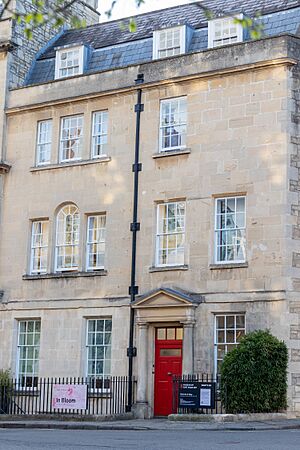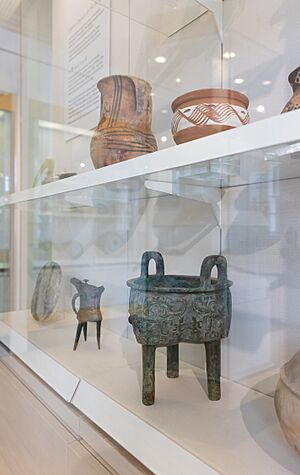Museum of East Asian Art, Bath facts for kids
The Museum of East Asian Art, also known as MEAA, is a special art museum in Bath, England. It is located in a beautiful old Georgian building in the center of the city. This museum is unique because it is the only one in the United Kingdom focused only on the arts and cultures of East and Southeast Asia.
The museum has nearly 2,000 amazing objects. These items range from around 5000 BCE (that's about 7,000 years ago!) to today. You can see ceramics (like pottery), jades, bronzes, and bamboo carvings. These treasures come from countries like China, Japan, Korea, and Southeast Asia. The museum's collection began with Brian McElney, a lawyer who worked in Hong Kong for many years. He loved East Asian art and started collecting it.
Contents
The Museum's Story
The Museum of East Asian Art was started by Brian McElney. He spent his career as a lawyer in Hong Kong. During that time, he became very interested in East Asian art, especially Chinese art. In 1958, he bought his first piece, a small ivory sculpture of a goat. After that, his collection grew to include many jades, ceramics, and bronzes.
After Brian McElney retired in 1983, he returned to England. He found the money to fix up and prepare the old Georgian building that now holds the museum. He officially founded the museum in 1990. Mr. McElney gave his entire private collection to the museum. He set it up as a charity to help educate people in the UK. The museum first opened its doors to the public in April 1993. While most of the objects came from his original gift, new items have been added over the years through donations and purchases.
Since it opened, the museum has become one of the largest collections of East Asian art outside of London. It is still the only museum in the UK completely dedicated to the arts and cultures of East and Southeast Asia. With almost 2,000 objects, the museum helps visitors learn about the art and traditions of China, Japan, Korea, and Southeast Asia. It also has one of the best jade collections in the UK, showing the amazing skill of East Asian artists.
Bath's Connection to East Asia
The city of Bath has its own history linked to China. In the 1700s, Chinese tea and porcelain were very popular and important for trade in England. Bath was the second most popular place after London for these activities. By the mid-1700s, drinking tea had become a big part of social life in Bath.
The museum shows this historical link through its collection of Armorial Porcelain. These are special porcelain pieces made for important families in Bath during the 1700s. One example is the Pratt Family Tureen. This piece was bought with help from several organizations, including the Museums, Libraries and Archives Council (MLA), the Victoria and Albert Museum (V&A), and The Art Fund charity.
What You Can See at the Museum
The Museum of East Asian Art has a permanent collection of ceramics, jades, bronzes, and bamboo carvings. These are displayed in the museum's two upper galleries. These galleries hold most of the nearly 2,000 objects, which date from around 5000 BCE to the present day.
The museum also hosts special temporary exhibitions throughout the year. They have a full schedule of events that go along with these shows. For example, in 2008, the museum won an award for its "Season of Tibet" exhibitions. This was one of their most popular series of shows and events. In 2010, an exhibition of modern papercuts was so well-liked that it was kept open longer.
The museum also shares its collection with other places. It is a partner in a traveling exhibition organized by the National Geographic Society. This exhibition includes almost 100 items from the museum's collection. When the exhibition was in Oman, the United Nations Secretary General Ban Ki-moon visited it. He was so impressed that he wanted the exhibition to come to the United Nations Headquarters in New York.
The Museum of East Asian Art also has a quarterly events program. They host many events both at the museum and in other locations. These have included talks by experts like Lars Tharp from the Antiques Roadshow. They also hosted Bath's first East Asian Film Festival.
A Challenging Time in 2018
On April 17, 2018, some people broke into the museum. They took 48 objects from the collection. These items included 22 jades, 10 ceramics, and a special mirror from the Tang era. The museum closed for a short time after this event. It reopened to the public on May 3, 2018. In May 2019, the local police announced that 18 of the damaged objects had been returned to the museum.



